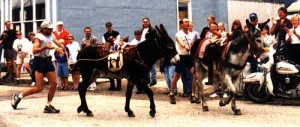Review by Virginia Simmons
Railroads – March 2004 – Colorado Central Magazine
Rio Grande Railroad
by James R. Griffin
Published in 2003 by MBI Publishing Co.
ISBN 0-7603-1442-X
JAMES R. GRIFFIN’S text about the Denver and Rio Grande is a very welcome, readable survey of the history of Colorado’s favorite railroad. It covers the beginnings of William Jackson Palmer’s narrow-gauge line in the 1870s; its evolution into a modern diesel-powered operation; its amalgamation with lines in northwestern Colorado and Utah; and finally its demise as a separate corporation in the 1990s.
In no other single book have I found as much about the corporate and economic history of this railroad. Without losing his way amid the local details and incidents that train buffs normally dote on, Griffin has produced an excellent history.
The D&RG’s economic ups and downs — mostly downs — during the first half of its life comprise a saga of harsh competition, receiverships, bankruptcies, bad decisions by Eastern managers, long periods of poor maintenance, and loss of traffic. With the return of management to Westerners, particularly Wilson McCarthy, the second half of the D&RG’s existence — as the Denver and Rio Grande Western — witnessed decades of vigorous growth and good management. Fast service was emphasized, until its merger with the Southern Pacific, and then its subsequent purchase by the Union Pacific, resulted in drastic change.
As part of the Southern Pacific Lines system, traffic increased along the Upper Arkansas-Tennessee Pass route for a short period of time. But after its purchase by the Union Pacific, large-scale shifts in traffic patterns halted the use of the Tennessee Pass route, as dismayed communities and rail fans are well aware.
Passenger traffic was mostly gone from the D&RGW several years earlier, with only AMTRAK’s train on leased track and the Ski Train through the Moffat Tunnel remaining as a vestige of this once-popular form of transportation.
A reader of Griffin’s text will emerge with enough information to understand why trains no longer roll through Salida, Buena Vista, and Malta, although the author does not make explicit statements on this subject. The reader will conclude, though, that on the one hand, there was the bottom line; and on the other hand, there were the takeovers by the SP and the UP — business practices which are all too common in today’s world — and also Philip Anschutz, the multifarious billionaire investor, today’s version of Jay Gould.
At first glance, browsers may assume that Rio Grande Railroad is a typical train book because of its abundance of fine photographs. Taken by several photographers, there are about 100 color images and about half as many black- and-whites, only a few of them old archival prints. The majority of subjects are modern diesel equipment, with some nostalgic views of steam locomotives like those that one usually finds in railroad books. Scrutiny of the photos and their captions will reveal that they have a life of their own, for their subjects are not integrated with the text. This dichotomy can be attributed chiefly to a layout artist who apparently had not read the text and was oblivious to chronology and geography. Another cause of the book’s split personality lies in captions which offer more data about types of locomotives than about history.
THIS QUIBBLE PROBABLY will not bother hard-core railfans, to whom types of locomotives and their identifying numbers are important matters. Such knowledge tends to separate the sheep and the goats among railroad enthusiasts. An example of this difference is an elegant photograph of “a pair of GP30s” crossing U.S. 50 at Maysville, en route to the limestone quarry on Monarch Pass on June 30, 1981. A serious fan might have great interest in GP30s, led by No. 3013, whereas someone else might have more interest in the railroad’s role in the history of the quarry and the use of limestone at CF&I in Pueblo.
But while I was examining all those photographs in Rio Grande Railroad, I was forced to rue my ignorance about diesel locomotives, and I began to rectify it by studying the photos, distinguishing the characteristics of different types, purposes, periods of use, and so on. I was helped along with historical information about equipment found in Griffin’s text.
Consequently, I emerged from this endeavor with new-found knowledge about things like the famous tunnel motors. In case, like me, you were wondering, tunnel motors were designed in such a way that a locomotive ran cooler to prevent excessive buildup of heat radiating from a hot diesel engine in a tunnel, with consequent stalling. Stalling in a tunnel is not desirable, especially with a long, heavy train still on the grade. Readers probably will discover other interesting facts about railroading.
Among the many railroad books on my shelf, Rio Grande Railroad will take a prominent and permanent place. It is a volume that will appeal to everyone who is interested in Colorado’s railroad history.
–Virginia McConnell Simmons



